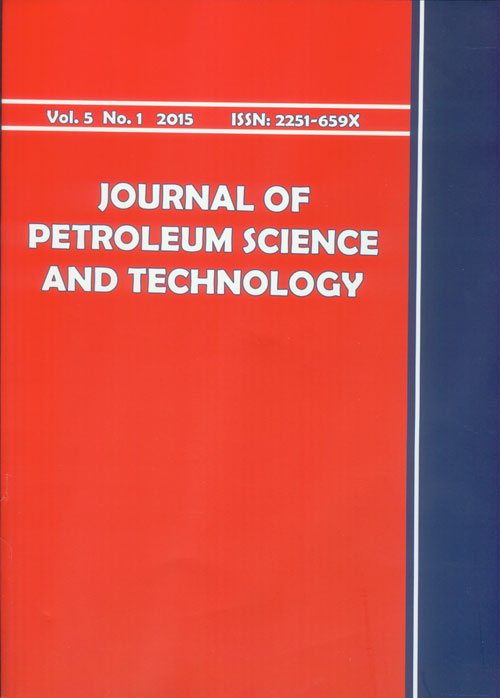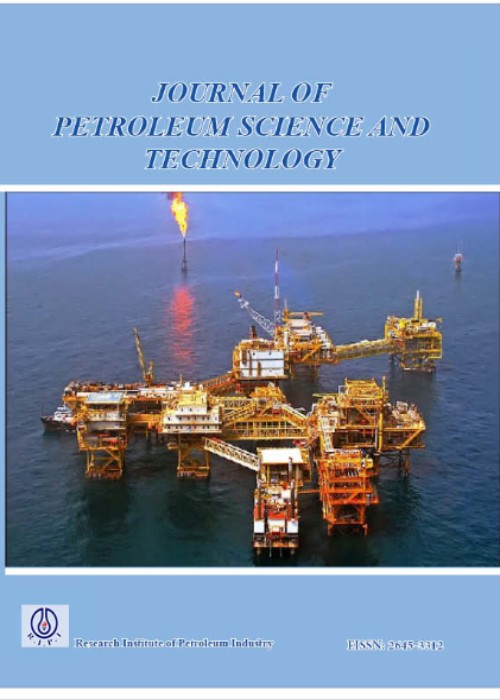فهرست مطالب

Journal of Petroleum Science and Technology
Volume:5 Issue: 1, Winter 2015
- تاریخ انتشار: 1393/12/17
- تعداد عناوین: 8
-
-
Pages 1-9Crude glycerol (CG) is an abundantly available and cheap by-product from biodiesel production. Value-added applications for CG are highly wanted by industry and several processes such as the use of CG for enhanced oil recovery have been proposed. The aim of this study was to evaluate the sulfide production of sulfate-reducing bacteria (SRB) indigenous to oil reservoirs using CG as substrate. The samples of CG were obtained from a biodiesel production plant, processing castor beans, soybeans, cotton, and waste oils and fats. Growth tests were performed in Postgate medium, with different types and concentrations of CG, and a mixed inoculum of SRB isolated from the produced water of a mature oil well of Bahia (Brazil). The experiment was monitored by measuring the concentration of sulfide using a colorimetric method. The results showed that SRB grew and produced more than 250 ppm sulfide at CG concentrations of 2%. However, at CG concentrations of 3% or higher, the biogenic production of sulfide was reduced. The study demonstrates that CG will likely stimulate SRB in oil fields, whenever CG is present at lower concentrations. Maintaining CG concentrations inhibitive to SRB will not certainly be achievable throughout oil reservoirs. Dosing CG to oil fields may lead to problems associated with souring in longer terms. The utilization of CG by SRB could in turn be interesting for other biotechnological processes, e.g. metal recovery processes based on precipitation with biologically formed sulfide.Keywords: Souring, Sulfate, reducing Bacteria, Crude Glycerol, Inhibition
-
Pages 10-20Foam injection is widely applied in amounts of fields to drilling, production, and formation protection. Sometimes, the application result is disappointing, which is caused by the failure of bubble generation in foam flooding. Therefore, it is necessary to seek ways for improving the performance of foam injection. An increased disturbance to the stratum, like the vibration caused by a seismic oil recovery technique, would be helpful. In the current work, the seepage of air foam in porous media under low frequency (LF) vibration is analyzed with experiments and an investigation of bubble creation/destruction rate change is carried out using mathematical modeling. The resistance factor of foam flooding under indoor vibration increases by 1.5 times and the valid time is obviously extended compared with when no vibration is used. The optimal vibrating acceleration and frequency of 0.7 m/s2 and the natural frequency of the cores-nearby of 18 Hz are achieved in the indoor experiments. Under vibration, the bubble generation rate increases, while bubble break rate by internal expansion or by gas diffusion and transfer decreases. An interesting phenomenon is also observed, which might develop a power level formula between the initially defined dimensionless MRF (maximum foam flooding resistance factor) and dimensionless DMRF (duration of maximum foam flooding resistance factor). The power product and sum of the power exponents of the above formula both equal approximately to 1. With the assistance of LF vibration, the increase of security, adaptability, and efficiency in foam injection may improve the reservoir recovery and extend its application.Keywords: Air Foam Flooding, Low Frequency Vibration, Resistance Factor, Foam Stabilization, Low Permeable Reservoir
-
Pages 21-27The Fischer-Tropsch synthesis (FTS) has been recognized as a heterogeneous surface-catalyzed polymerization process. During this process, CHx monomers formed via the hydrogenation of adsorbed CO on transition metals produce hydrocarbons and oxygenates with a broad range of chain lengths and functional groups. A series of Fe/Cu Fischer-Tropsch synthesis catalysts incorporated with a calcium promoter were prepared by a microemulsion method. The composition of the final nanosized iron catalysts in terms of the atomic ratio is as follows: 100Fe/4Cu, 100Fe/4Cu/2Ca, 100Fe/4Cu/4Ca. XRD, BET, TEM, and TPR techniques were used to study the catalysts phase, structure, and morphology. Fischer-Tropsch synthesis (FTS) reaction test was performed in a fixed bed reactor. All the promoted catalysts, compared to the unpromoted catalysts, have higher rates of FT and the secondary reaction for CO2 production. The formation of methane and light hydrocarbons is restrained with increasing the amount of calcium. The 100Fe/4Cu/2Ca shows the best performance between the prepared catalysts.Keywords: Nanoparticle Iron Catalyst, Fischer, Tropsch Synthesis, Calcium Promoter
-
Pages 28-39This study aims to identify favorable oil–gas reservoir facies in the Chishan group of the Wubao fault zone (Gaoyou sag, Subei basin, China) using the methods of outcrops and cores observation, granularity analysis, scanning electron microscope, log data, etc. The results suggest that the Chishan group in the studied area mainly develops desert sedimentary system, and contains five kinds of facies from bottom to top, namely dry salt lake, aeolian sand, intermittent river, fan delta, and salt lake facies; the Chishan group was divided two members according to the lithology and a sedimentary cycle of base-level. The lower member of the Chishan group in the Wubao fault zone contained dry salt lake, intermittent river, and aeolian sand facies. The upper member of the Chishan group in the Chenbao area consisted mainly of aeolian sand. The southwestern Zhousong area contained (from east to west) a succession of aeolian sand, intermittent river, fan delta, and salt lake facies. Among these facies, aeolian sand was divided into aeolian sand dune, interdune, and aeolian sand sheet three sub-lithofacies. In the aeolian sand dune, the sand dune was a typical micro-lithofacies and had a scattered distribution. The fan delta had a bead-like distribution along the main fault, in which mainly underwater distributary channel and sand bank were developed. The sand bodies of the sand dune, underwater distributary channel, and sand bank were all well developed, and had average porosity values of >20%, meaning that they were favorable oil–gas reservoirs. The interdune sediments were fine-grained and had low porosity and permeability. Hence the reservoir properties of the interdune sediments were poor, and they could represent either fluid interlayers of reservoirs or source beds.Keywords: Typical Micro, lithofacies, Facies, Chishan Group, Wubao Fault Zone, Gaoyou Sag
-
Pages 40-52The influence of Mo particle size on the catalytic activity and product selectivity of alkalized MoS2 nanocatalysts has been investigated. Nanocatalysts are prepared using a microemulsion technique with water-to-surfactant ratios of 1-12. Three different techniques, including XRD, TEM, and hydrogen chemisorption were used to determine the molybdenum average particle size and their activity and selectivity in higher alcohols synthesis (HAS) carried out in a fixed bed microreactor at 330 °C and 70 bar. To fix the percentage of CO conversion, the GHSV is changed from 3.6 to 2.57 (nl/(hr.g catalyst)). The average MoS2 particle sizes are changed from 4.5 to 11.9 nm. The experimental results showed that changing particle size from 11.9 to 4.5 nm decreased the methanol formation rate from 0.00634 to 0.00534 (mol/(hr.g catalyst)) but increased ethanol formation rate from 0.00581 to 0.00787 (mol/(hr.g catalyst)) and higher alcohols formation rate from 0.00473 to 0.00657 (mol/(hr.g catalyst)). A size-dependent kinetics model was developed to calculate the alcohol formation rates versus catalyst average particle size. The model not only matched experimental and theoretical results, but also showed that MoS2 catalyst had size-dependent structure and for the prediction of product selectivity it was easier to use this mathematical model.Keywords: Higher Alcohol, Rate, Selectivity, Particle Size, Size, dependent Kinetics
-
Pages 53-68The main purpose of this investigation is to study the effect of near miscible CO2 injection in different porous mediums on both lab and field scales. This effect can be traced by the change of two-phase gas-oil relative permeability curves. In this work, the experiments have been performed on three rock types (i.e. sandstone, dolomite, and artificial fractured sandstone) based on an incremental pressure algorithm approaching a near miscible condition. Lab-scale inverse modeling has been used to calculate relative permeability curves. Based on the experimental results, 85%of minimum miscibility pressure was defined as the near miscible pressure. Comprising the relative permeability curves in immiscible and near-miscible conditions, the results show that this change has become less significant from sandstone core type to artificial fractured. In other words, near miscible CO2 injection would be recommended in rock types with a lower RQI. In addition, it was concluded that in the case of artificial fractured, simple conventional relative permeability methods obtain the same results as sophisticated inverse modeling method. Furthermore, in order to validate the lab scale results, the field scale modeling of the candidate reservoir was done using the 3D compositional reservoir simulator. 83% of minimum miscibility pressure was defined as near miscible pressure. Moreover, the simulation results confirmed lab-scale data regarding the recovery factor in different rock types. Additionally, the economic evaluation (NPV analysis) showed that use of near miscible CO2 injection in lower RQI reservoirs was more economical rather than the other scenarios.Keywords: Near, miscible CO2 Injection, Lab, Field Scale, Inverse Modeling, Rock Types, Relative Permeability Curves, NPV Analysis
-
Pages 69-78The direct conversion of methane to C2 hydrocarbons, in a quartz tube reactor enforced by a DC corona discharge, was investigated at atmospheric pressure. The process was carried out in the presence of metal oxide catalysts of Mn/W/SiO2, Mn/W/SiO2 (tetraethyl orthosilicate, TEOS), and Mn/W/CNT (supported on carbon nanotubes). The total yield to C2 hydrocarbons in the presence of metal oxide catalysts in plasma environment was in the order of Mn/W/SiO2> Mn/W/SiO2 / TEOS> Plasma only> Mn/W/CNT. The order changes to Mn/W/SiO2>Mn/W/CNT>Plasma only> Mn/W/SiO2/ TEOS, when the selectivity and yield of ethylene is considered. The highest yield to C2 hydrocarbons was 15.8%, which was obtained by using Mn/W/SiO2 in combination with gas discharge plasma without external heating; it was lower when the same feed composition was tested over this catalyst at 825 °C. The catalyst Na2WO4/Mn2O3/SiO2 –b1, which produces the least carbon oxides, gives rise to the highest production of higher hydrocarbons and ethylene. Catalysts Na2WO4/Mn2O3/SiO2 /TEOS-b2 and Na2WO4/Mn2O3/CNT-b3,due to their high selectivity toward carbon oxides, show low efficiency in producing more valuable hydrocarbons.Keywords: Methane Conversion, Non, thermal Plasma, Catalysis, Metal Oxide, Hydrocarbons
-
Pages 79-90Permeability can be directly measured using cores taken from the reservoir in the laboratory. Due to high cost associated with coring, cores are available in a limited number of wells in a field. Many empirical models, statistical methods, and intelligent techniques were suggested to predict permeability in un-cored wells from easy-to-obtain and frequent data such as wireline logs. The main objective of this study is to assess different approaches to the prediction of the estimation of permeability in a heterogeneous carbonate reservoir, i.e. Fahliyan formation in the southwest of Iran. The considered methods may be categorized in four groups, namely a) empirical models (Timur and Dual-Water), b) regression analysis (simple and multiple), c) clustering methods like MRGC (multi-resolution graph-based clustering), SOM (self organizing map), DC (dynamic clustering) and AHC (ascending hierarchical clustering), and d) artificial intelligence techniques such as ANN (artificial neural network), fuzzy logic, and neuro-fuzzy. This study shows that clustering techniques predict permeability in a heterogeneous carbonate better than other examined approaches. Among four assessed clustering methods, SOM performed better and correctly predicted local variations. Artificial intelligence techniques are average in modeling permeability. However, empirical equations and regression methods are not capable of predicting permeability in the studied reservoir. The constructed and validated SOM model with 6×9 clusters was selected to predict permeability in the blind test well of the studied field. In this well, the predicted permeability was in good agreement with MDT and core derived permeability.Keywords: Permeability, Carbonate Reservoir, Clustering, Intelligent, Experimental Correlation


